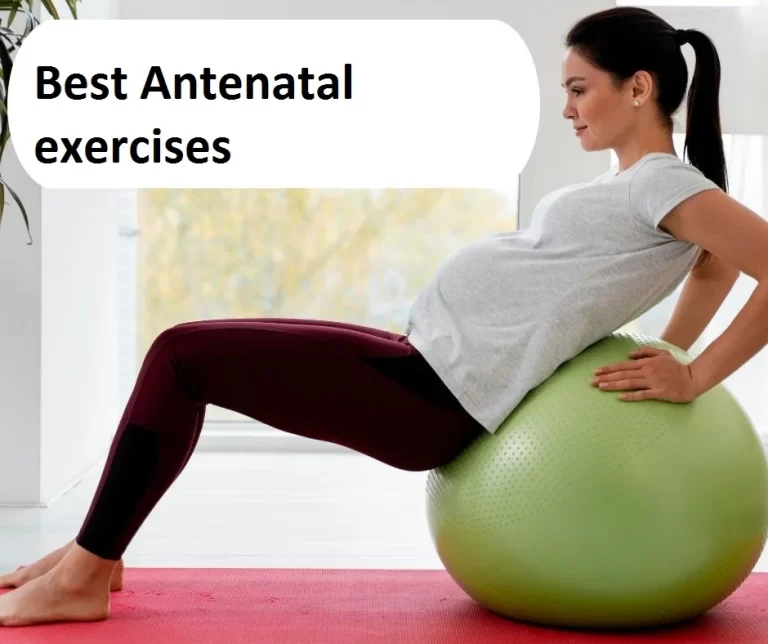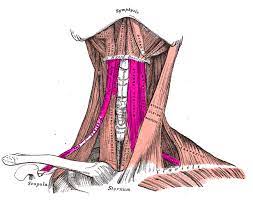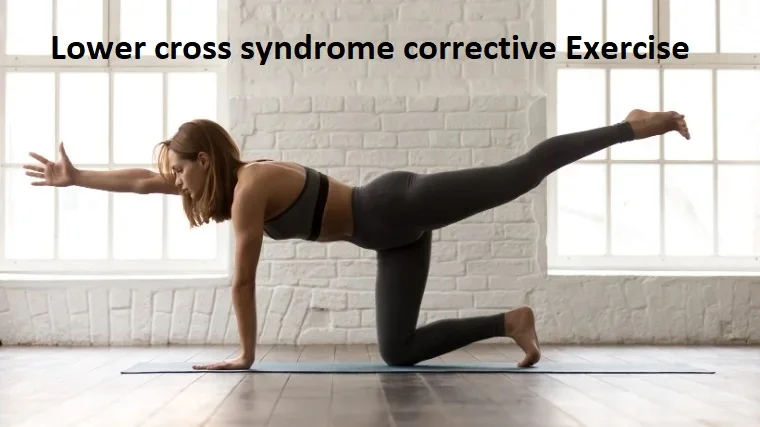30 Best Quadriceps Strengthening Exercises
Table of Contents
Introduction
- Quadriceps strengthening exercises are a great option to make the knee more powerful to improve sports performances and also help to do all the day-to-day activities more easily and also have many health benefits.
- Quadriceps muscles located at the front side of the thigh as well as perform all the day-to-day activities namely, walking, running, squatting, and sitting to standing. There are many health benefits if the person is doing this exercise regularly.
What are Quadriceps strengthening exercises?
- The quadriceps (or quads) are the group of four muscles located anterior of the thigh. This pulls together to help flex the hip as well as extend (or straighten) the knee. This consists of 4 single muscles rectus femoris, vastus lateralis, vastus medialis, as well as vastus intermedius.
- These muscles form the proportions of the thigh.
- The quadriceps usually become weak after an injury or surgery on the lower leg or thigh, So the therapist has to strengthen the quadriceps. An individual with specific conditions mostly has weakness in the quadriceps. These conditions include Patellofemoral stress syndrome, Iliotibial band friction syndrome, as well as Patellar tendonitis, or tendinosis.
- This article shows the person simple exercises that he can do at home to strengthen his quadriceps muscles.
- Some quadriceps exercises place a lot of stress on the knee joint. The Physio Therapist can show the patient ways to minimize joint stress while strengthening the quadriceps.
Some health benefits of doing quadriceps strengthening exercise
- Regularly doing quadriceps strengthening exercises can assist in making it easier to extend the knee as well as flex the hip.
- Assists in strengthening the quadriceps muscles.
- Assists in improving the stability of the kneecap.
- It helps to protect the knee joint from injury.
- Assists in increasing the jump height.
- Assists in improving overall athletic ability.
- Assists in reducing the risk of developing knee osteoarthritis.
- Helps to improve balance as well as stability.
- Stronger quadriceps make everyday actions easy such as walking, bending, & sitting, and running.
There are different exercises to strengthen the quadriceps muscles
Static Quadriceps exercise
- First of all, you have to take a supine position. After that, place a towel under the knee. Next, you can pull the toes up towards your shin, and push your knee into the bed to tighten the quadriceps muscles. This exercise should cause your heel to slightly lift off a bed.
- After completing this position, hold for ten seconds. Accomplish this exercise 10 times in one session. Do three sessions in one day.
- In progression: you have to just increase the time as well as increase the repetitions.

Straight Leg Raises
- How to do this strengthening exercise:
- The straight leg raise is a simple exercise to get the quadriceps muscles working properly.
- To do this exercise, a person has to lie on the back on a flat surface. Keep the right knee at a 90-degree angle.
- The foot should be flat on a surface. The left leg should be straight, and the toes pointing toward the ceilings.
- Gradually raise the left leg twelve to fifteen inches off the floor by contracting the anterior thighs.
- Hold for ten to fifteen seconds then slowly lower this down.
- It is the one repetition.
- Perform ten to fifteen repetitions on each leg for one to two sets in one day.
Short Arc Quads
- How to do this strengthening exercise:
- For this exercise, an individual has to lie on the back. Use a basketball to prop up the knee.
- After that, gradually extend the flexed knee until this is straight. Next, tighten the quadriceps muscle with the toes pointed upward.
- Hold this tight for five to ten seconds.
- Gradually lower down the leg.
- Do this ten to fifteen times for one to three sets on each leg. Do three sessions of these repetitions in one day.
Wall Slides
- How to do wall slides quadriceps strengthening exercise:
- This exercise utilizes multiple muscle groups in one exercise, containing the quadriceps, glutes, as well as hamstrings.
- For this exercise, a person has to stand upright with the back against a wall & shoulder feet width apart.
- Gradually flex the knees, sliding the back down a wall for a count of five to ten until the knees are bent at a 45 to 50-degree angle.
- Do not flex too much further than this, as this will put too much pressure on the knees.
- Hold this for 5 five to ten seconds. After that, extend the knees by gradually sliding a wall until the person is fully upright with the knee straight.
- Do this strengthening exercise ten to twenty times in one session. Do three sessions in one day.
Goblet Squat
- Stand with the feet a shred wider than hip-width apart, toes just turned out, having a dumbbell with both hands in front of you so it
- To embark on this exercise: You just hang vertically.
- Engage your core as well as keep your chest lifted & back flat as you shift your weight into your heels, press your hips back, as well as bend your knees to lower into the squat position.
- Next, drive through your heels to stand as well as squeeze your glutes at the top for one repetition.
- Do this goblet squat ten times in the initial stage. After that, increase the repetition from ten to fifteen around after five days. Do two sessions of fifteen repetitions in one day.
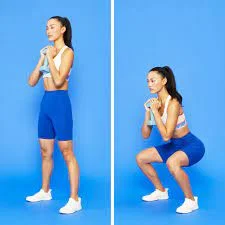
Eccentric Squat exercise
- For performing this exercise: you have to place your feet hip-width apart, core engaged, and hands clasped at chest height. (You may also hold the dumbbell in front of your chest or even two racked on your shoulders for the extra challenge.)
- Over the course of five seconds, gradually lower into the squat by sending your hips back as well as bending both knees until your thighs are parallel to the ground.
- Next, pause for a second at the bottom of the motion, then press through your heels to quickly come back to the standing position. The longer you pause at the bottom, the harder this will be. It is one repetition.
- Do seven to eight repetitions in one session. Do two sessions in one day.
- In progression:
- You can hold the end position for nearly five seconds. Increase repetitions from seven to fifteen in one session. Do two sessions in one day.
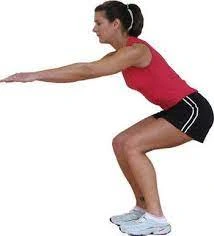
Terminal Knee Extension
- How to do this strengthening exercise:
- Terminal knee extension (TKE) is a simple as well as effective exercise to strengthen the quadriceps muscle in the standing position.
- The TKE is considered a functional exercise. The quadriceps will be working while supporting the body weight.
- For this exercise, a person needs the resistance band. After that, place the resistance band around the steady object so this is anchored.
- This will be the same height as the knee.
- Now step into a resistance band & face the anchored point with a resistance band looped around a knee joint.
- Slightly flex the knee joint. Gradually extend the knee, & place tension on a band, a resistance band should provide some
- resistance as the person tries to fully extend the knee.
- Once the knee is fully extended & the band is tight, hold the position for three to five seconds then slowly flex the knee.
- Do this strengthening exercise ten to twenty times in one set. Do two to three sets in one day.
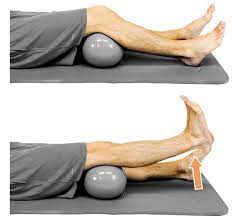
Body weight squat
- How to do this strengthening exercise:
- This is the best exercise to strengthen the lower limb as well as the core muscles.
- For this exercise, an individual has to stand with shoulder feet width apart as well as toes pointing upward & outwards.
- The arms should be by the side. The hands on the hips or even clasped together. The core muscles should be tight & chest up, push the hip backward & knee flexed as if the person is doing a sitting.
- Stop when the thighs are parallel to the floor & hold for a couple of seconds at that point.
- Push through the heels and come back to the starting position. Do around ten repetitions in one session. Do three sessions in one day.
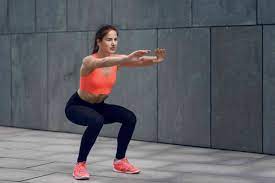
Wall Squat with Leg Raise
- From the starting position, gradually lower your body down & hold for a time. After that, extend your knee. Hold for three to five seconds
- initially.
- As you improve, lengthen the amount of time you hold a wall squat as well as knee extended position. Be sure to keep your pelvis, back, & head against a wall. Keep the motion pain-free.
- Perform three sets of five repetitions once per day. Progress the time held up to ten seconds per repetition.
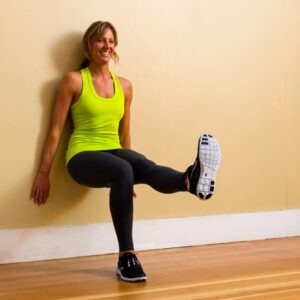
Walking lunge
- How to do this strengthening exercise:
- These are very simple exercises to boost the leg as well as core muscles. An individual can do this in an easy way by doing lunge only or he makes it challenging by using dumbbells.
- For this exercise, the person has to stand tall with shoulder feet width apart.
- The hands should be placed on the hips, or if an individual is using dumbbells then place the hands by the sides.
- Take a forward step by the right foot & sink down until the front knee is at 90 degrees & the back shin is parallel to the floor.
- Next, hold for five to ten seconds at that point, now step forward from the left leg.
- Keep taking steps from the alternate leg as the patient lunges forward. Perform ten repetitions in one session. Do three sessions in one day.
Step-up
- How to do this strengthening exercise:
- This is a great way to work on knee stabilization. Using the lower box makes this exercise easy.
- For this exercise, a person needs one box or the step stool & any other object of just lower to knee height.
- After that, place your right foot on a box as well as step up, the knee should be aligned with the ankle & not let this collapse inward.
- When the person takes a step up, focus on driving through heels & the posture should be tall when the person pushes the left knee upward until this is at the same height as the hip.
- Now step backward as well as step-up gain with the opposite foot.
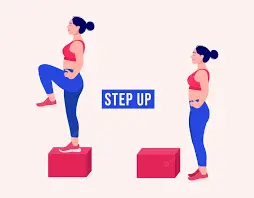
Kneeling Leg Extension
- To start this exercise: You may get into the kneeling position with your knees hip-distance apart, torso tall, core as well as legs engaged, & hands on your hips. It is the embarking position.
- After that, keeping a flat back as well as hips extended, gradually tip your torso backward until your buttocks are a few inches away from your heels. Pause, then gradually reverse the motion to come back to the embarking position. It is one repetition.
- This bodyweight move really targets your quadriceps, since you have to raise as well as lower your torso using primarily just the strength of your quadriceps. Do this exercise 10 terms in one session. Accomplish two sessions in one day.
- In progression. Hold the end position of hip extension, with increment in repetition to ten in one session.
Bulgarian split squat
- How to do this strengthening exercise:
- This exercise puts more emphasis on the stabilizing muscles of the knee as well as the hip than traditional squats.
- The person can make them easier by going only halfway down.
- For this exercise, the person has to stand with the feet shoulder-width apart, about 2 steps away from the bench, the box, or another knee-high surface.
- Next, rest the top of the right foot on the bench behind you, & step the left foot forward far enough that the person can squat without the knee going past the toes.
- Lean forward as well as lower down until the anterior thigh is almost parallel to the floor.
- Do ten to fifteen repetitions on each side.
Lateral lunge (side lunge)
- How to do this strengthening exercise:
- For this exercise, the person has to stand with the shoulder hip-width apart as well as arms in front of the patient’s face for balance.
- Take a big step to the left as well as start pushing the hips back as the person bends his left knee to assume the squat position.
- After that, squat down as far as possible, or until the thigh is parallel to the floor.
- Come back to the starting position as well as repeat this on another side.
- Do 8 to 10 repetitions on each side in one session. Do three sessions in one day.
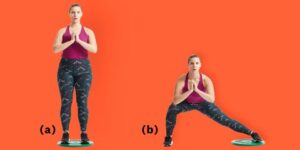
Squat jump
- How to do this strengthening exercise:
- First of all, squat jumps are a great exercise to build lower body power.
- For this exercise, a patient can start with five repetitions per set instead of ten.
- An individual has to take a basic squat position with the feet shoulder-width apart as well as the hands in front of her.
- After that, squat down until the thighs are almost parallel to the floor & then do a powerful jump up.
- Now land gradually with slightly flexed knees, before going to the next repetition.
Box jump
- How to perform this strengthening exercise:
- For this exercise, a person needs one box as well as standing about one step away from a box with the feet shoulder-width apart.
- After that, flex the knees & place the arms behind you until he is in a quarter squat.
- Now swing the arms forward, extend the hip joint as well as jump upward on a box. Next, land with slight knee flexion.
- Step down & do it again. Do around ten repetitions in one session. Perform three sessions in one day.
Single-leg squat
- How to do this type of strengthening exercise:
- This exercise requires more strength, mobility, as well as balance.
- If a person can not get into a full squat position, he can put the chair behind his body to limit how far down he goes.
- For this exercise, a person has to stand with their foot together & arms in front of them. After that, lift the right foot off the floor & keep it in front of the body with the leg straight.
- Now squat down on the left leg until the thigh is parallel to the floor. Come back to the starting position & repeat this on the right leg.
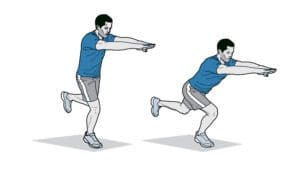
Forward Lunge exercise
- First of all, to do this exercise, you have to stand with your feet hip-width apart as well as your core engaged.
- After that, step forward with your right foot & bend both knees to 90 degrees to sink into the lunge.
- Next, push off your right foot to come back to the embarking position.
- Repeat on the other side as well.
- Do this exercise seven to ten times in one session. Do two sessions in one day.
- In progression: Hold the end position for five seconds. Do ten repetitions in one session. Perform two sessions in a day.
Reverse Lunge to Knee-Up Jump
- To initiate this strengthening exercise: You just stand with your feet about shoulder-width apart & engage your core.
- Then, step backward with the right foot, landing on a ball of your right foot as well as keeping your right heel off the floor.
- Next, bend both knees to 90 degrees as you sink into the lunge, then swing your right arm forward, elbow bent, as well as your left arm slightly back, elbow bent.
- After that, focus on keeping the core engaged & your hips tucked (do not stick your buttocks out).
- Push through the left foot to jump up as high as you can, driving the right knee toward your chest.
- The land gradually as well as softly on your left foot & then immediately sink back into another lunge. It is one repetition.
- Complete nine repetitions in one set. Do three sets in one day. Then switch sides & repeat.
- In progression. Try to hold the end position for around ten seconds with ten repetitions on one side. Perform two sets in one day.
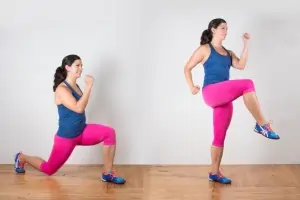
Sumo Squat
- For doing this strengthening exercise: First of all, you may stand with your feet wider than shoulder-width apart, & toes turned out about 45 degrees. Next, hold the kettlebell by the horns with both hands. (You may also do this with the dumbbell.) It is the starting position.
- After that, bend your knees as well as push your hips back as you lower down into the squat.
- Drive through the heels to come back to the standing position and squeeze your glutes at the top. This is our one repetition, do it ten times in a session. Do two sessions per day.
- In progress: You just keep the end position for ten seconds. Do ten repetitions per session. Do three sessions in one day (if possible).
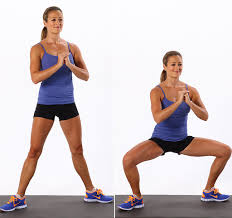
Back Squat
- First of all, You may grab a barbell inside the squat rack with your hands a bit wider as compared to your shoulder.
- From there, duck underneath a bar as well as push your upper back against a bar, so that the bar is resting on the very top of the upper back. After that, squeeze your shoulder blades together to create the muscular “shelf” for a bar to rest on.
- Next, stand up tall and walk backward a few steps away from a squat rack & place your feet slightly wider than shoulder-width apart, and turn the feet out a little, 20 to 30 degrees.
- Now, push your hips back & bend your knees to lower into the squat, pushing the knees slightly out to the sides. Only squat as profoundly as the mobility allows.
- Next, push through both feet to stand back up, and this is one repetition. Do fifteen times in one session. Do two sessions in one day.
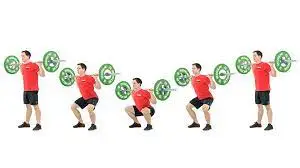
Wide Squat to Narrow Squat
- To do this wide squat to narrow squat quadriceps strengthening exercise: You may hold a dumbbell by both ends horizontally at chest level & stand with the feet hip-width apart, core engaged.
- Next, from this more narrow stance, perform a squat by sending the hips back & bending both knees. This is okay if the squat is not as deep as your other squats typically are.
- Come back to the standing position, and step out wide to the right with your right foot.
- Then, Squat again by sending the hips back with the feet wide apart. You can find this comfortable to adjust your toes by turning them out slightly.
- Then, stand & come back to your embarking position, & do a narrow squat again.
- On your next wide squat, step out wide with the left foot.
- Continue to alternate the foot you step out with for the wide squats. Do ten times in one set. Perform three sets in one day.
Bridge Exercise
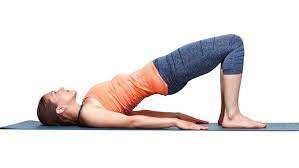
- Find the open space on the ground as well as lie on your back, using the mat if you have one. Next, rest your hands at the sides, bend your knees, as well as place your feet flat on the ground, beneath your knees.
- After that, tighten your abdominal as well as buttock muscles by pushing the lower back into the floor.
- Then, raise your hips to create a straight line from the knees to your shoulders.
- Squeeze your core & pull your belly button back toward the spine.
- Hold this position for twenty to twenty-five seconds.
- Lower the hips to come back to the embarking position.
Variations
Elevated Feet
- If you prefer to perform the basic bridge with some support under your feet, then try the elevated bridge. For this variation, you will need an inflatable exercise ball.
- Start in the beginning position for the basic bridge with an exercise ball at your feet.
- Place the heels on the top of a ball.
- Next, raise your pelvis as you would in a basic bridge.
- Perform this exercise fifteen times per set. Do two sets per day.
- In progression: you just hold the end position on the ball for nearly ten seconds and do this exercise ten times in one set. Do two sets in one day.
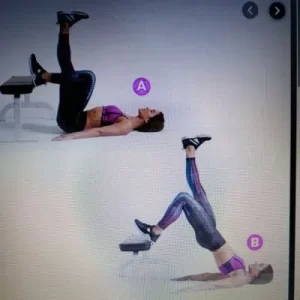
Single Leg Bridge
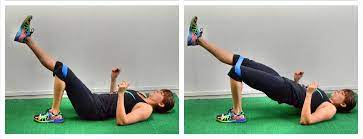
- First of all, to do this strengthening exercise: Lie on your back with your hands by the sides, knees bent, as well as feet flat on the ground (under your knees). Lift one foot, extending a leg fully so this is roughly 45 degrees to the ground. It is the embarking position.
- Then, raise your hips, tightening your abdominals & buttock muscles to support the lift, until your shoulders, as well as knees, are in a straight line. After that, squeeze your core at the same time, as if trying to pull the belly button back toward the spine.
- Hold the position for a count of one, two, or three.
- Next, lower the hips to the ground gradually and with control, holding the leg extended, to come back to the embarking position.
- Repeat on the same leg for the needed number of repetitions.
- Keep your core engaged throughout the action.
- In progression: You just hold the end position of the single-leg bridge for ten seconds. Do fifteen repetitions in one session. Perform two sessions in one day.
Single-Leg Bridge Exercise With Lowered Leg
- This exercise adds even more intensity to a single-leg bridge by incorporating leg motion while the pelvis is in a raised position.
- Start in the embarking position for a basic bridge.
- Next, raise your left leg as you raise the pelvis up.
- After that, lower the left leg until this is almost touching the ground while keeping the pelvis in the raised position.
- Lift a leg back up as well as hold before lowering your hips back down to the ground.
- Perform this exercise fifteen times per session. Do two sessions per day.
Bridge March
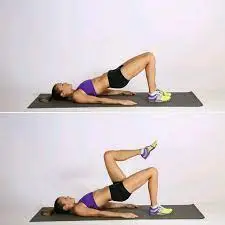
- If you are getting bored with the basic move & have mastered the single-leg bridge, try the bridge march next.
- Start in the starting position for the basic bridge.
- As you raise the pelvis up, lift your left leg, bringing your knee close to the core.
- After that, lower your left leg back down, and raise the right leg, bringing your knee to the abs.
- Do fifteen repetitions in one session. Perform two sessions per day.
Plank Exercise Raise
- To do this strengthening exercise, you may take a prone position. After that, keep your chin tucked down so you are looking straight at the floor. Your thighs, buttocks, stomach, as well as back muscles, are all engaged. The elbows should be directly under the shoulders.
- Then, keep your body straight, do not tilt.
- Do two sets of ten seconds once per day with ten repetitions.
Single-leg squat (pistol squat)
- The pistol squat is a challenging squat variation that requires strength, mobility, as well as balance. If you cannot get into the full squat position, you may put a chair behind you to limit how far down you go.
- Beginners may not attempt this exercise. This is best to try this move only once you can comfortably do the previous nine exercises.
- Muscles worked: quads, glutes, core, as well as the inner thigh.
- Instructions
- First of all, stand tall with your feet together as well as your arms in front of you.
- Next, lift one foot off the ground & keep it in front of your body with your leg straight.
- Squat down on the opposite leg until your thigh is parallel to the ground.
- Then, come back to the embarking position & repeat with the other leg.
- Safety Tips
- Stop if you feel knee pain at any time.
- Go only as low as you can without feeling discomfort or irritation.
- Go only as low as you can while still being able to control the knee.
When did the person not do this exercise?
- If the doctor recommended him to take rest.
- If the leg bone is recently fractured.
- If the person feels knee pain while doing any exercise explain above.
- Stop doing exercise if the person feels any knee discomfort.
- Avoid doing box jumps if he has knee pain.
- Avoid stepping so far that the person feels discomfort in the groin.
FAQ
Quadriceps muscle wasting is the common clinical observation in patients with lower limb disease, injury, or as a result of immobilization. One theory is that pain causes reflex inhibition of the quadriceps muscle, which in time induces the atrophic response within the muscle with subsequent loss of muscle size.
Even though knee pain can result from multiple factors including both biological and/or psychosocial, studies suggest that quadriceps muscle weakness may contribute to worsening knee pain. Contrarily, greater quadriceps muscle strength has been shown to prevent further damage to the knee joint structures.
Tighten the straight knee to lock this out as well as lift the leg up to the height of the other knee. You should be able to complete this action with the knee locked straight, if the knee bends a little & bobbles then you have some quad weakness.
You may see small results even two to four weeks after you start a leg workout. You will have better stamina, as well as your legs will look a little more defined. But all in all, depending on the fitness levels, this does take three to four months for any remarkable difference.
Muscles from the quadriceps as well as hamstrings to the gluteus maximus & the erector spinae (lower back) all have to work to
maintain stability while this single-leg phase. Therefore, walking assists to strengthen these muscles & improve stability, one leg at a time.
The quadriceps muscles are one of the largest muscle groups in the body, & are also the main drivers of the knee joint. When your quadriceps muscles are tight, they prevent full motion of the tendons supporting your knee, applying greater pressure on the kneecap.

